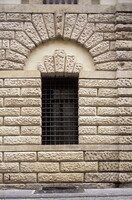Palazzo Thiene
Palladio, Andrea; Giulio Romano

Download1A1-PA-PT-B1_cp.jpg (712.2Kb)
Date
1542-1556Description
Frontal view of a window; Also in 1542 Palladio began rebuilding the Palazzo Thiene (only partly completed) in Vicenza. Scholars are not unanimous in attributing this building to Palladio, although Palladio himself claimed authorship of it by including it in his Quattro libri, an attribution supported by Vasari. For some scholars, however, Vincenzo Scamozzi's assertion that the building was originally started by the Roman architect Giulio Romano, and the rusticated treatment of the parts of the facade that were executed, are reason enough to attribute the building to the latter. The structure is a massive palace rising directly from ground-level and recalling a fortress rather than a Renaissance town palace. The rock-faced rusticated masonry of the ground floor, in which the windows look as if they are cut out, is continued in smoother and shallower form on the piano nobile. The upper storey is articulated by a series of pilasters in a regular rhythm and enlivened by windows surmounted alternately by triangular and segmental pediments. The columns flanking the windows are clad with small blocks that interrupt the curvature of the column, a further allusion to the fortress quality of the palace. The tripartite composition of the whole consists of a sequence of façade, atrium and inner courtyard, each expressed as clearly distinct zones. The richly varied forms designed by Palladio for the axially linked room plans in the self-contained wings of the palace are derived directly from the architecture of Roman baths. Source: Grove Art Online; http://www.groveart.com/ (accessed 1/26/2008)
Type of Work
palazzoSubject
architectural exteriors, Renaissance
Rights
Rights Statement
Licensed for educational and research use by the MIT community only